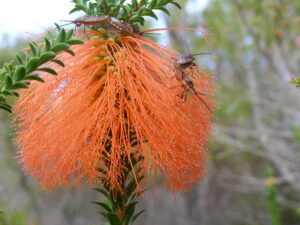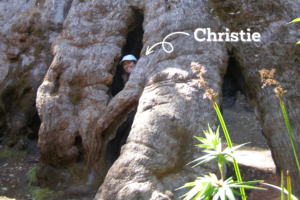
From tingle trees shaped like teapots and foaming karri forest, to prehistoric snails and fields of orange flowers, Senior Ranger Christie Bentink has all your must-sees-and-dos at Walpole-Nornalup National Park sorted!
Christie took the time to sit down with us and share some of the things she loves most about the park, her favourite free family activities, as well as some fantastic recommendations and interesting history.
Hi Christie! What do you love most about Walpole-Nornalup National Park?
Hi there! Well, I’ve been in this role for 12 years, and we cover seven parks across the Walpole Wilderness. And I think I love Walpole-Nornalup National Park so much because it kind of surrounds our town and our community. And, it’s pretty much part of our lives every day.
One thing I love about the park is the diversity of landscapes. So, we’ve got all these amazing ocean landscapes, where the parks butt onto the Southern Ocean. And Walpole-Nornalup National Park also surrounds the Walpole-Nornalup Inlets Marine Park. So, we have marine park, surrounded by the lush, green national park.
But the most special thing about Walpole-Nornalup to me is the tingle trees and the remnant Gondwanan, relic forest. You know, we’ve got the oldest eucalypts around. There’s only 6000 hectares of forest with tingle, growing in it, and it’s all around Walpole. I love that you can walk into the tingle trees… I think there’s just something really special about them.
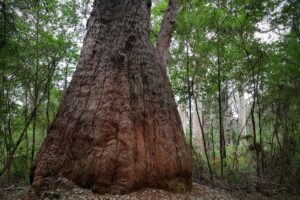
Tell us more about the tingle trees!
I feel like the tingles, you know, they have their own personality.
On the Mount Clare trail, there’s a tingle tree that’s shaped like a teapot! For kids, it’s great to get their imagination going a bit. And that’s only a 1-kilometre walk to the summit, so it’s doable for little ones.
Grandma tingle is a definite favourite – you can see her on the Ancient Empire Walk.
There’s also a whole new trail system that’s just been built around the Valley of the Giants. And it takes you past a tree called the Pleated Lady, which is this beautiful, big, red tingle, and its buttress is shaped like a pleated skirt!
Try and spot all the tingle tree characters on your next visit! Can you make up a story about each of them?
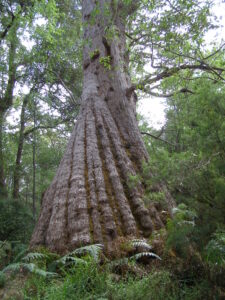
What are some of your other top spots for families to visit?
A passion of mine is the Bibbulmun track. You can go hiking along there with kids – say, from the Giant Tingle to Hilltop Lookout, it’s three kilometres one-way. You can get on the Bibbulmun track and go visit some big trees, and there’s really beautiful forest along the way.” For more information on this trail, visit the AllTrails website.
The Ancient Empire Walk is a great one. It’s free, and it’s a really nice family experience. We’re actually upgrading it and making most of it universally accessible. So, for families that might have prams or wheelchairs or an elderly member, it’s a great spot. I think even if you’re not going on the Tree Top Walk itself, the Ancient Empire Walk is still SO worth a visit.
Another place is Conspicuous Cliffs. I just loved going there when my kids were little – it’s definitely a spare clothes type of place! It’s two-wheel drive accessible, and you basically end up down on a beach. But there’s this freshwater river that comes out onto the beach and into the ocean. So, you have the ocean, which is kind of wild and a little bit dangerous but quite a distance away, and the kids can just play in the river on the beach, and it’s safe. They can make dams and splash in it and have fun. And, in winter, from the lookouts at the top of the cliffs, you can actually watch for whales as well.
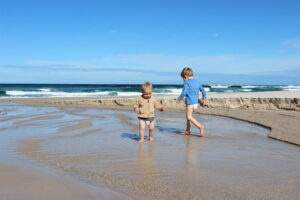
Make a list of these amazing places and check them off as you visit!
- Bibbulmun Track: Giant Tingle to Hilltop Lookout
- Ancient Empire Walk
- Conspicuous Cliffs
What time of year can people visit to see something unique?
Obviously, spring is beautiful with the wildflowers. But my favourite time of the year, personally, is autumn. We still get some beautiful wildflowers out. There’s one that looks a bit like a bottle brush – it’s called Beaufortia sparsa, it’s bright orange and you get fields of them in the national park.
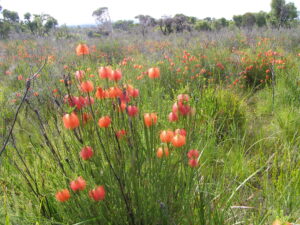
You get those really nice still days where the sun’s warm, but it’s not too hot and it’s not too windy, and the inlet glasses off like a mirror. You start getting the first winter rains as well, and the tingle trees actually foam! So, there’s sap in the bark, and when you get the really big rains to start the winter (which is usually mid-end of May) you get these foaming trees, which is really cool.
I just love fungi as well. I’ll take my kids out into the forest and we’ll just go look for fungi of all shapes, sizes and colours.
So, autumn is definitely my favourite. And you know, when things have been hot and dry, and you get that first rain, that smell is just beautiful!
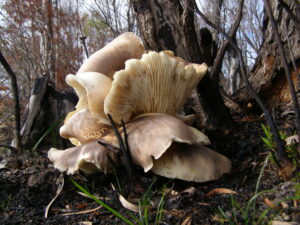
Can you pick a favourite plant and animal?
That’s tricky!
We have such high rainfall here – we still get probably about 1000 to 1200 mL per year annually – which means it’s still wet enough to sustain those old relic species. Like, the tingle trees! And we have a tingle spider, and the Bothriembryon snail. The snails love the wet forest, and they’ve got a really cool stripey shell! I love the fact that they evolved from 65 million years ago.
The Leucopogon verticillatus, or tassel flower, is one of my favourite plants. Basically, ‘verticillatus’ means the spokes of a wheel, which makes sense when you look at the leaves! And during spring, there are these little purple tassels that come off the plant – it’s amazing.
Use these images to see if you can find a Bothriembryon snail or tassel flower in the park.
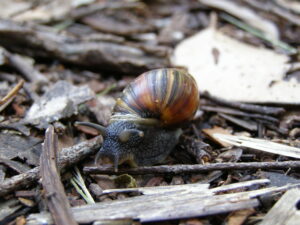
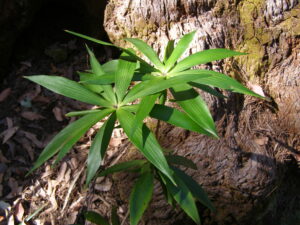
What about a favourite place within the park?
I love Monastery Landing – the quietness and being on the river. It’s also kind of where the Walpole Wilderness began, so there’s a bit of history there.
In 1910, there was a family who had come and settled in little tents around the Frankland River. The man of the family, Pierre Bellanger, was pretty crucial in getting things rolling down here.
Sir James Mitchell was the Minister for Agriculture around the Perth settlement at the time. One of his goals was to come down and open up some land for agriculture. So, he and some other dignitaries came down here and obviously saw a lot of karri forest, which was hard to clear and not conducive to extensive farming. And on this one occasion, Pierre Bellanger took Sir James Mitchell and a couple of other dignitaries up the river in the boat on the Frankland River.
Then, they got to a particularly beautiful spot where James Mitchell, who was awestruck, said, “Ah, this is just so beautiful. It’s quiet as a monastery.” And on the spot in that boat, he declared to set aside 52 hectares as Class A Reserve, which was the highest conservation value you could give a park at the time.
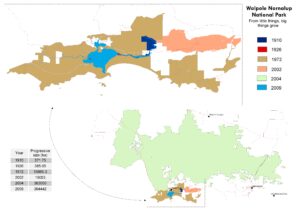
Over time, that reserve grew and grew to encompass more of the area – including the Valley of the Giants treetop walk in 2002. Then, in 2004, Walpole-Nornalup stretched out to encompass the whole Walpole Wilderness, which is more than 360,000 hectares now.
So, it all started almost 100 years prior. I just love that, and when you go there, you can just feel that essence of what a park is… you know, why we love parks and why we want to get out into parks. Because somehow, you just connect with things on a deeper level. Your mind quietens down, you can hear the running water and the birds, and you can just stop and breathe.
Visit Monastery Landing and see if you can sense its special history. Try closing your eyes or sitting on the ground amongst the trees.
Please note: The access road to Monastery Landing is seasonally closed in the wetter months.
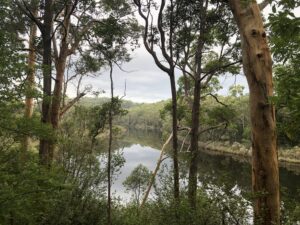
Nature Play WA would like to thank Senior Ranger Christie Bentink for taking the time to chat with us and share her extensive knowledge about Walpole-Nornalup National Park. For more resources that can help you plan your trip to Walpole-Nornalup National Park, visit the Every Kid in a Park section of our website.

